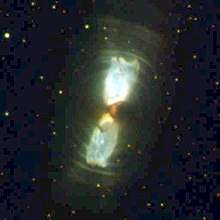Cotton Candy Nebula
The Cotton Candy Nebula is considered to fall into an unusual category of astronomical objects known as protoplanetary nebulae or post-AGB star.[1] A proto-planetary nebulae is an astronomical object that is in a stellar evolution phase where the star begins to discard its outer layers and is about to proceed to becoming a true planetary nebula, which is another astronomical object made up mostly of gaseous materials that was originally discovered by the IRAS satellite. IRAS was launched in January 1982 and overlooked about 97 percent of the sky.[2] It is also known as IRAS 17150-3224. It is a good example of a DUPLEX-type protoplanetary nebula.[3]
| Reflection nebula | |
|---|---|
| Protoplanetary nebula | |
 | |
| Observation data: epoch | |
| Right ascension | 17h 18m 20s |
| Declination | −32° 27′ 22″ |
| Constellation | Ara |
The Cotton Candy Nebula is difficult to spot considering it is only 16′′ long and hardly shines. Michael E. Bakich is an Astronomy senior editor and has studied the Cotton Candy Nebula. He has confirmed that the way to spot the nebula is with the help of a 16'' scope.[1] With the help of the IRAS 17150-3224 and the nebulae being in the perfect position where the starlight is blocked, we were able to examine the ring-like structures that "cocoon" the nebula as astronomer Sun Kwok put it.[2] The spherical ring structures around the nebulae are created throughout the red-giant stage which is the ultimate stage in stellar evolution.[2]
References
- Bakich, Michael (May 2010). "Target 30 obscure celestial gems: this list of faint, fainter, and faintest deep-sky targets will take your observing skills to the next level". Astronomy: 64 – via gale in context biography.
- Kwok, Sun (October 1998). "Stellar metamorphosis" (PDF). Sky & Telescope: 30 – via Gale Biography in Context.
- HST polarimetry of PPN
| Wikimedia Commons has media related to Cotton Candy Nebula. |